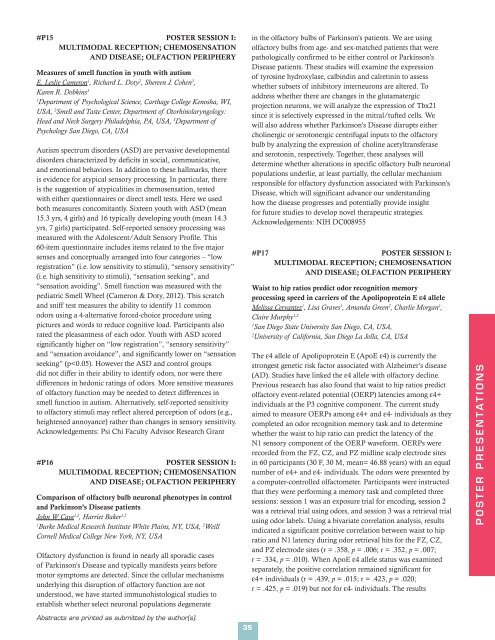Abstracts - Association for Chemoreception Sciences
Abstracts - Association for Chemoreception Sciences
Abstracts - Association for Chemoreception Sciences
You also want an ePaper? Increase the reach of your titles
YUMPU automatically turns print PDFs into web optimized ePapers that Google loves.
#P15 POSTER SESSION I:<br />
MULTIMODAL RECEPTION; CHEMOSENSATION<br />
AND DISEASE; OLFACTION PERIPHERY<br />
Measures of smell function in youth with autism<br />
E. Leslie Cameron 1 , Richard L. Doty 2 , Shereen J. Cohen 3 ,<br />
Karen R. Dobkins 3<br />
1<br />
Department of Psychological Science, Carthage College Kenosha, WI,<br />
USA, 2 Smell and Taste Center, Department of Otorhinolaryngology:<br />
Head and Neck Surgery Philadelphia, PA, USA, 3 Department of<br />
Psychology San Diego, CA, USA<br />
Autism spectrum disorders (ASD) are pervasive developmental<br />
disorders characterized by deficits in social, communicative,<br />
and emotional behaviors. In addition to these hallmarks, there<br />
is evidence <strong>for</strong> atypical sensory processing. In particular, there<br />
is the suggestion of atypicalities in chemosensation, tested<br />
with either questionnaires or direct smell tests. Here we used<br />
both measures concomitantly. Sixteen youth with ASD (mean<br />
15.3 yrs, 4 girls) and 16 typically developing youth (mean 14.3<br />
yrs, 7 girls) participated. Self-reported sensory processing was<br />
measured with the Adolescent/Adult Sensory Profile. This<br />
60-item questionnaire includes items related to the five major<br />
senses and conceptually arranged into four categories – “low<br />
registration” (i.e. low sensitivity to stimuli), “sensory sensitivity”<br />
(i.e. high sensitivity to stimuli), “sensation seeking”, and<br />
“sensation avoiding”. Smell function was measured with the<br />
pediatric Smell Wheel (Cameron & Doty, 2012). This scratch<br />
and sniff test measures the ability to identify 11 common<br />
odors using a 4-alternative <strong>for</strong>ced-choice procedure using<br />
pictures and words to reduce cognitive load. Participants also<br />
rated the pleasantness of each odor. Youth with ASD scored<br />
significantly higher on “low registration”, “sensory sensitivity”<br />
and “sensation avoidance”, and significantly lower on “sensation<br />
seeking” (p
















